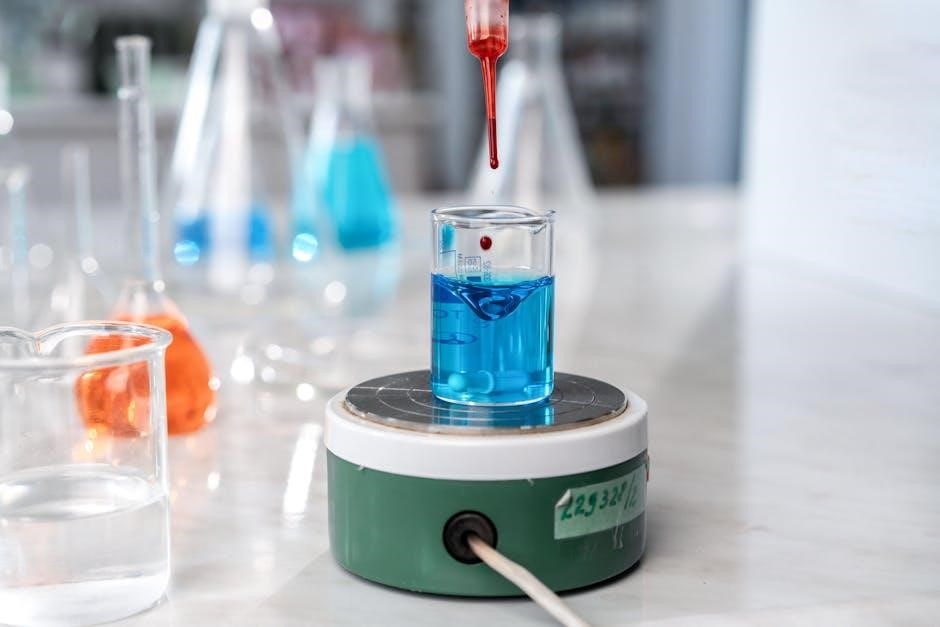A chemical reaction involves the transformation of reactants into products through atomic rearrangement‚ adhering to the law of conservation of mass. Understanding reactions is fundamental in chemistry‚ as they explain how substances interact and change. Studying chemical reactions helps predict and control processes in various fields‚ from cooking to industrial manufacturing. This guide provides foundational knowledge and practical insights to master chemical reactions effectively.
1.1 Definition and Importance of Chemical Reactions
A chemical reaction is a process where one or more substances (reactants) are transformed into new substances (products) through atomic rearrangement. According to Dalton’s atomic theory‚ reactions involve the redistribution of atoms without their creation or destruction. This process adheres to the Law of Conservation of Mass‚ ensuring the total mass remains constant. Understanding chemical reactions is essential in chemistry‚ as they explain how materials interact and change. They are fundamental in various fields‚ including cooking‚ industrial processes‚ and biological systems‚ making them a cornerstone of scientific study and practical applications.
1.2 Key Concepts in Chemical Reactions
Key concepts in chemical reactions include reactants‚ products‚ catalysts‚ and activation energy. Reactants are substances that undergo change‚ while products are the new substances formed. Catalysts speed up reactions without being consumed. Activation energy is the minimum energy required for reactants to react. Chemical equations symbolize reactions‚ showing reactants and products. Understanding these concepts is vital for analyzing and predicting reaction outcomes‚ making them foundational in chemistry.

Types of Chemical Reactions
Chemical reactions are classified into synthesis‚ decomposition‚ single-replacement‚ double-replacement‚ combustion‚ acid-base‚ and redox reactions. These categories help understand reaction mechanisms and predict outcomes in chemistry.
2.1 Synthesis Reactions
Synthesis reactions‚ also known as combination reactions‚ involve two or more reactants combining to form a single product. The general form is A + B → AB. These reactions are fundamental in chemistry‚ often used in manufacturing processes like fertilizer production. For example‚ nitrogen and hydrogen combine to form ammonia (NH₃)‚ a critical step in the Haber-Bosch process. Similarly‚ elements like oxygen and phosphorus can combine to form oxides. Synthesis reactions are essential in both industrial applications and natural processes‚ such as the formation of water from hydrogen and oxygen.
2.2 Decomposition Reactions
Decomposition reactions involve a single reactant breaking down into two or more simpler substances. The general form is AB → A + B. These reactions often require energy input‚ such as heat or light. A classic example is the decomposition of hydrogen peroxide (H₂O₂) into water (H₂O) and oxygen gas (O₂). Decomposition reactions are crucial in processes like the production of oxygen in space exploration and in biological systems‚ such as cellular respiration. They also play a role in industrial processes‚ such as the breakdown of limestone into calcium oxide and carbon dioxide.
2.3 Single-Replacement Reactions
Single-replacement reactions involve one element displacing another from a compound. The general form is A + BC → AC + B. These reactions often occur between metals and acids or salts. For example‚ zinc reacts with hydrochloric acid to produce zinc chloride and hydrogen gas. These reactions are fundamental in metal extraction‚ electrochemistry‚ and industrial processes. The activity series of metals helps predict the likelihood of such reactions occurring‚ as more reactive metals displace less reactive ones from their compounds.
2.4 Double-Replacement Reactions
Double-replacement reactions occur when two compounds exchange ions or molecules‚ forming two new compounds. The general form is AB + CD → AD + CB. These reactions often result in the formation of a precipitate‚ gas‚ or water. For example‚ sodium sulfate and barium chloride react to form barium sulfate (a precipitate) and sodium chloride. These reactions are critical in various industrial processes‚ such as water softening and the production of pharmaceuticals. Identifying the solubility of compounds is key to predicting the products of these reactions.
2.5 Combustion Reactions
Combustion reactions involve the reaction of a substance with oxygen‚ typically producing heat and light. The general form is fuel + oxygen → carbon dioxide + water + energy. These reactions are exothermic and often involve hydrocarbons‚ such as methane or gasoline‚ burning in air. Combustion is a fundamental process in engines‚ heating systems‚ and industrial processes. Understanding combustion is crucial for energy production‚ environmental science‚ and safety protocols‚ as it releases harmful pollutants like CO and NOx if not controlled properly.
2.6 Acid-Base Reactions
Acid-base reactions involve the transfer of protons (H⁺ ions) between substances. Acids donate protons‚ while bases accept them‚ forming water and a salt. These reactions are exothermic and often used in neutralization processes. For example‚ HCl (acid) reacts with NaOH (base) to produce NaCl and water. Acid-base reactions are vital in chemistry‚ biology‚ and environmental science‚ influencing pH levels and chemical equilibria. They also play a key role in industrial processes‚ such as water treatment and pharmaceutical manufacturing.

Chemical Equations and Stoichiometry
Chemical equations and stoichiometry are fundamental tools for describing chemical reactions. They involve writing balanced equations‚ mole ratios‚ and applying these principles to calculate theoretical yields and limiting reactants.
3.1 Writing and Balancing Chemical Equations
Writing and balancing chemical equations is essential for representing chemical reactions accurately. A chemical equation uses symbols to show reactants‚ products‚ and the direction of the reaction. To balance an equation‚ assign coefficients to ensure equal numbers of atoms on both sides. Start with the most complex molecules and adjust coefficients systematically. The law of conservation of mass dictates that atoms are neither created nor destroyed. Always check that the equation is balanced for all elements and that the simplest whole-number ratios are used.
3.2 Mole Ratios and Stoichiometric Calculations
Mole ratios‚ derived from balanced chemical equations‚ are fundamental for stoichiometric calculations. These ratios allow determination of the amount of reactants required or products formed. Using molar masses‚ convert moles to grams or volumes for real-world applications. Limiting reagents are identified by comparing mole ratios of reactants to the balanced equation. Calculations also involve percentage yield‚ comparing theoretical and actual amounts of products. Accurate stoichiometry is critical in chemistry for predicting outcomes and optimizing processes‚ ensuring efficiency in experiments and industrial applications.
3.3 Limiting Reactants and Excess Reactants
The limiting reactant determines the maximum amount of product in a reaction‚ while excess reactants remain unreacted. To identify them‚ compare the mole ratios of reactants to the balanced equation. Calculate the required moles of each reactant and determine which is consumed first. Limiting reactants are crucial for predicting yields and optimizing reactions. Accurately identifying them prevents waste and ensures efficient resource use‚ especially in industrial processes. Understanding this concept is vital for controlling reaction outcomes and scaling chemical processes effectively.
3.4 Percentage Yield and Theoretical Yield
Theoretical yield is the maximum amount of product predicted by stoichiometric calculations‚ assuming all reactants are fully consumed. Percentage yield compares actual yield to theoretical yield‚ indicating reaction efficiency. It is calculated as (actual yield / theoretical yield) × 100. Factors like side reactions‚ incomplete reactions‚ and losses during purification lower percentage yield. Understanding these concepts helps assess reaction performance and optimize experimental conditions. Accurate calculations are essential for both laboratory experiments and industrial processes to evaluate efficiency and refine methods accordingly.
Chemical Reaction Kinetics
Chemical kinetics studies reaction rates‚ mechanisms‚ and factors influencing them. It explores how concentrations‚ temperature‚ and catalysts affect reactions‚ aiding in predicting and optimizing reaction outcomes.
4.1 Rate of Reaction and Factors Affecting It
The rate of a chemical reaction measures how quickly reactants are converted into products. It is influenced by several factors‚ including the concentration of reactants‚ temperature‚ surface area‚ catalysts‚ and the nature of the reactants. Increasing concentration or temperature typically accelerates the reaction‚ while catalysts lower activation energy. Surface area also plays a role‚ as larger surfaces allow more collisions. Understanding these factors is crucial for predicting and controlling reaction speeds in various chemical processes.
4.2 Rate Laws and Reaction Orders
A rate law expresses the relationship between the rate of a reaction and the concentrations of reactants. It is typically written as Rate = k[A]^m[B]^n‚ where k is the rate constant‚ and m and n are the orders of reaction with respect to reactants A and B. The overall reaction order is the sum of m and n. Reaction orders can be zero‚ first‚ second‚ or even third order‚ depending on the mechanism. Determining the rate law experimentally is essential for understanding reaction kinetics.
4.3 Determining Rate Constants
The rate constant ( k ) is determined experimentally by measuring reaction rates under various conditions. Methods include the initial rate method‚ where concentrations of reactants are varied systematically. Plots of rate vs. concentration are analyzed to find ( k ). Temperature significantly affects ( k )‚ as described by the Arrhenius equation. The units of ( k ) depend on the reaction order. For first-order reactions‚ ( k ) is in ( ext{s}^{-1} )‚ while second-order reactions have ( k ) in ( ext{M}^{-1} ext{s}^{-1} ). Accurate ( k ) values are crucial for predicting reaction rates under different conditions. Experimental data and graphical analysis are essential tools in determining ( k ).
4.4 Catalysts and Their Role in Reactions
Catalysts are substances that accelerate chemical reactions without being consumed. They lower the activation energy by providing an alternative reaction pathway‚ allowing reactions to occur faster or at lower temperatures. Catalysts are highly specific and can be homogeneous (in the same phase as reactants) or heterogeneous (different phase). Enzymes‚ metals‚ and acids are common catalysts. They are widely used in industrial processes‚ such as catalytic converters in cars and in biological systems for digestion. Catalysts enhance reaction efficiency and are reusable‚ making them vital in both laboratory and real-world applications.
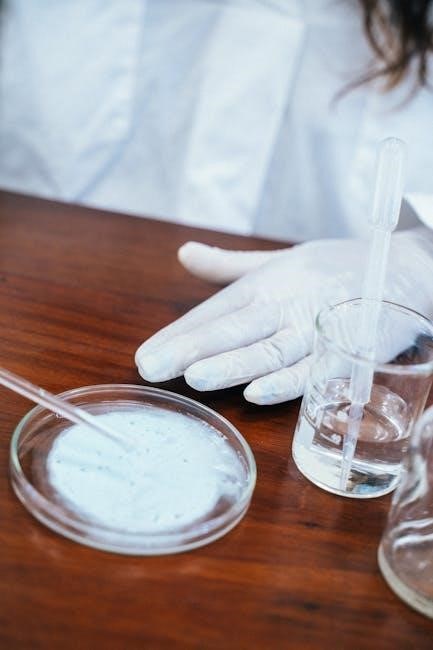
Thermodynamics of Chemical Reactions
Thermodynamics explores the energy changes and heat transfer in reactions‚ covering endothermic and exothermic processes. It examines entropy‚ Gibbs free energy‚ and factors determining reaction spontaneity and feasibility.
5.1 Endothermic and Exothermic Reactions
Endothermic reactions absorb heat from the surroundings‚ often feeling cold to the touch‚ while exothermic reactions release heat‚ producing warmth. Endothermic processes require energy input‚ such as melting ice‚ whereas exothermic reactions‚ like combustion‚ release energy. These classifications help predict whether reactions will increase or decrease the temperature of their environment. Understanding these concepts is crucial for controlling reaction conditions and predicting energy flow in various systems.
- Endothermic: Heat is absorbed (ΔH > 0).
- Exothermic: Heat is released (ΔH < 0).
5.2 Entropy and Gibbs Free Energy
Entropy measures disorder or randomness in a system‚ while Gibbs free energy predicts reaction spontaneity. A positive change in entropy (ΔS > 0) indicates increased disorder‚ favoring reactions. Gibbs free energy (ΔG) combines enthalpy (ΔH) and entropy (ΔS) via ΔG = ΔH ― TΔS. Reactions with ΔG < 0 are spontaneous. Understanding these concepts helps determine whether reactions will occur naturally and how energy is distributed in a system. They are fundamental for analyzing thermodynamic feasibility and direction of chemical processes.
- ΔG determines reaction spontaneity.
- ΔS reflects system disorder.
5.3 Spontaneity of Chemical Reactions
Spontaneity determines if a reaction occurs naturally under specific conditions. It is governed by Gibbs free energy (ΔG). If ΔG is negative‚ the reaction is spontaneous; if positive‚ it is non-spontaneous. Temperature‚ enthalpy (ΔH)‚ and entropy (ΔS) influence spontaneity via ΔG = ΔH ― TΔS. Reactions tend to proceed toward equilibrium‚ balancing forward and reverse rates. Concentration‚ pressure‚ and catalysts can shift equilibrium but do not affect ΔG. Understanding spontaneity helps predict reaction direction and feasibility under given conditions.
- ΔG determines spontaneity.
- Reactions proceed toward equilibrium.
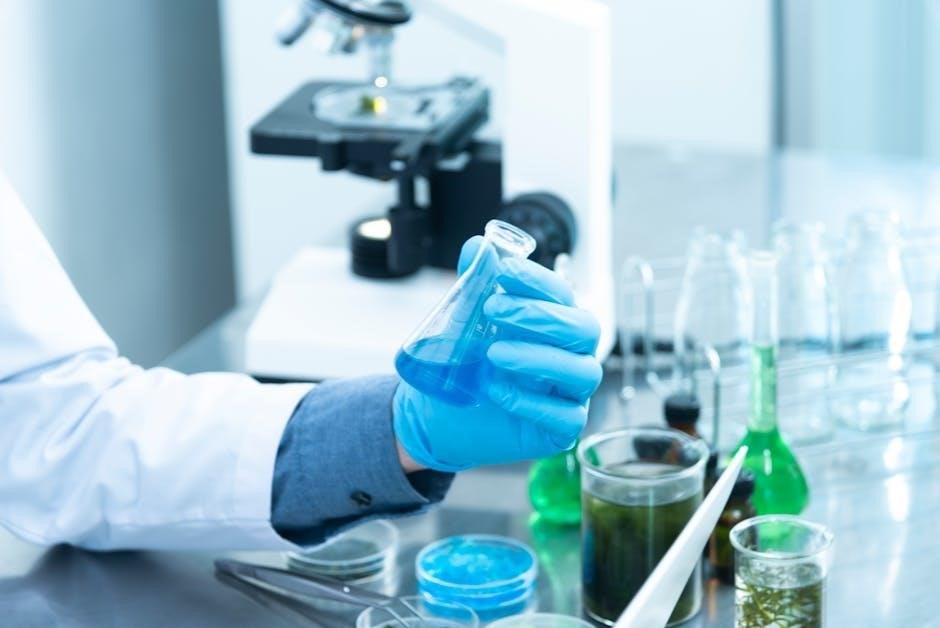
Reaction Mechanisms
Reaction mechanisms outline the step-by-step processes by which reactants transform into products‚ including intermediate steps and transition states. They explain how reactions proceed.
6.1 Steps in a Reaction Mechanism
A reaction mechanism is a detailed description of the steps through which a chemical reaction occurs. It includes elementary steps‚ each representing a single molecular event. These steps describe the formation and breakdown of intermediates‚ substances formed during the reaction but not appearing in the overall equation. Transition states‚ high-energy moments between reactants and products‚ are also identified. By breaking down the reaction into these steps‚ chemists can understand the pathway and determine the rate-determining step‚ which dictates the overall reaction speed.
6.2 Rate-Determining Steps
The rate-determining step (RDS) is the slowest step in a reaction mechanism and dictates the overall reaction rate. It acts as the bottleneck‚ influencing the rate law and reaction kinetics; The RDS often involves the breaking of bonds‚ requiring the most activation energy. Identifying the RDS is crucial for understanding how reaction conditions‚ like catalysts‚ affect the reaction speed. Catalysts lower the activation energy of the RDS‚ thereby accelerating the reaction. The rate law is typically derived from the RDS‚ making it a critical concept in reaction mechanisms and chemical kinetics.
6.3 Intermediate and Transition States
Intermediates are species formed in one step of a reaction mechanism and consumed in a subsequent step. They are not present in the overall balanced equation but are crucial for understanding the reaction pathway. Transition states represent the highest energy state during the conversion of reactants to products. They are temporary and cannot be isolated. Intermediates and transition states help explain the sequence of events in a reaction mechanism. Their identification aids in determining the rate law and understanding the reaction’s progress. Both concepts are vital for analyzing reaction pathways and kinetics.
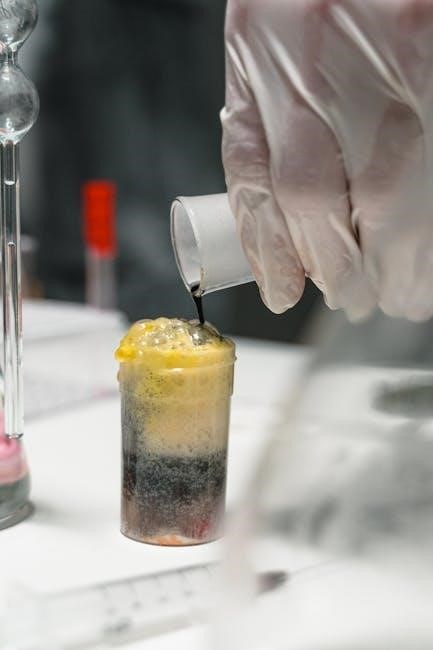
Laboratory Observations and Data Recording
Accurate observations and precise data recording are critical in chemical reactions. Proper documentation ensures reproducibility and validity of experimental results‚ essential for scientific research and analysis.
7.1 Proper Use of Laboratory Equipment
Proper use of laboratory equipment is crucial for conducting safe and accurate chemical reactions. This includes handling glassware‚ measuring instruments‚ and electronic devices with care. Students should learn to calibrate instruments‚ follow manufacturer guidelines‚ and use protective gear. Understanding the function of each tool‚ such as burettes‚ pipettes‚ and thermometers‚ ensures precise measurements and minimizes errors. Regular maintenance and decontamination of equipment are also essential to prevent cross-contamination and ensure reliable results in experiments involving chemical reactions.
7.2 Recording Observations and Data
Accurate recording of observations and data is vital in chemical reactions. Note physical changes‚ colors‚ odors‚ and temperature variations. Use standardized units and precise measurements. Document both quantitative and qualitative data‚ such as volumes‚ masses‚ and reaction rates. Maintain a neat and organized lab notebook‚ dating entries and including sketches or graphs. Data integrity ensures reliable analysis and reproducibility of experiments. Consistent and thorough documentation helps identify patterns and draw valid conclusions‚ making it a cornerstone of scientific inquiry and learning in chemical reactions.
7.3 Safety Precautions in the Lab
Ensuring safety in the lab is critical when studying chemical reactions. Always wear protective gear like gloves‚ goggles‚ and lab coats. Read chemical labels carefully and handle substances in well-ventilated areas. Familiarize yourself with emergency equipment‚ such as fire extinguishers and eye wash stations. Avoid eating or drinking in the lab. immediately clean up spills and dispose of waste properly. Follow procedures for heating substances and never leave reactions unattended. Adherence to safety protocols minimizes risks and ensures a secure environment for conducting experiments and learning about chemical reactions.

Common Chemical Reactions in Everyday Life
Chemical reactions are integral to daily life‚ from photosynthesis in plants to digestion in the human body. They occur in cooking‚ combustion engines‚ and battery operations‚ shaping our routines and technologies.
8.1 Chemical Reactions in Cooking and Food
Cooking involves numerous chemical reactions that transform ingredients. The Maillard reaction occurs when amino acids and sugars react with heat‚ creating browned flavors. Emulsification happens in mixtures like mayonnaise‚ where oil and water combine using emulsifiers. Starch gelatinization softens foods like pasta when heated. Fermentation‚ driven by microorganisms‚ produces yogurt and bread. Denaturation changes egg proteins when scrambled. These processes highlight how chemistry underpins culinary techniques‚ making food preparation both an art and a science.
8.2 Chemical Reactions in Industrial Processes
Industrial processes rely heavily on chemical reactions to produce materials and goods. The Haber process synthesizes ammonia for fertilizers‚ while petroleum refining involves cracking hydrocarbons to produce fuels. Steel production uses reduction reactions to purify iron. Polymerization creates plastics like polyethylene. These reactions often involve catalysts and precise process control to maximize efficiency and safety. Understanding these industrial reactions is crucial for developing sustainable manufacturing practices and meeting global demand for materials.
8.3 Chemical Reactions in Biological Systems
Chemical reactions are fundamental to biological systems‚ driving processes like metabolism‚ DNA replication‚ and respiration. Enzymes act as catalysts‚ accelerating reactions such as glycolysis and protein synthesis. Photosynthesis converts light energy into chemical bonds‚ while cellular respiration releases energy from food. Hormone regulation and neurotransmitter signaling rely on precise chemical interactions. These reactions maintain homeostasis‚ enabling life to function. Understanding them is vital for medicine‚ agriculture‚ and biotechnology‚ offering insights into health‚ disease‚ and ecosystem balance.

Tips for Studying Chemical Reactions
Use active recall‚ focus on understanding concepts‚ and utilize visual aids. Regular practice with problems enhances retention and mastery of reaction mechanisms and stoichiometry.
9.1 Effective Note-Taking Strategies
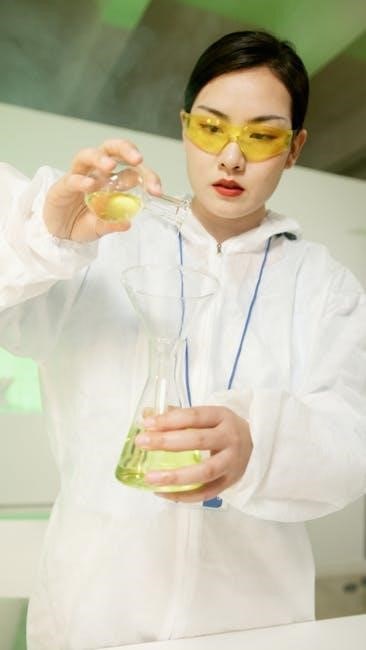
Organize notes systematically‚ separating topics like reaction types and stoichiometry. Use bullet points and symbols for clarity. Highlight key terms and concepts. Review and summarize notes weekly‚ linking new information to prior knowledge. Record examples and practice problems to reinforce understanding. Maintain a dedicated section for frequently confused reactions or formulas. Use color coding to differentiate reaction types‚ making revision more efficient. Regularly cross-reference with textbooks or online resources to fill knowledge gaps. This structured approach ensures comprehensive retention and easier exam preparation.
9.2 Practicing Problems and Past Exams
Regular problem-solving strengthens understanding of chemical reactions. Start with basic stoichiometry and gradually move to complex questions. Use textbooks‚ online resources‚ and past exams for varied practice. Time yourself to simulate exam conditions‚ focusing on weak areas. Review mistakes to avoid repeating them. Organize practice sessions by topics‚ such as synthesis or acid-base reactions. Explain concepts in simple terms to reinforce learning. Take breaks to avoid burnout and maintain focus. Track progress to identify improvement areas and stay motivated.
9.3 Using Visual Aids and Mnemonics
Visual aids like flowcharts‚ diagrams‚ and infographics can simplify complex reaction concepts; Mnemonics‚ such as acronyms or rhymes‚ help memorize reaction types and steps. For example‚ associating reaction pathways with images or stories enhances retention. Flashcards can reinforce key terms and processes. Interactive tools‚ like videos or simulations‚ provide dynamic learning experiences. These methods make studying engaging and effective‚ especially for visual learners. Combining visuals with mnemonics creates a powerful strategy for mastering chemical reactions and their underlying principles.
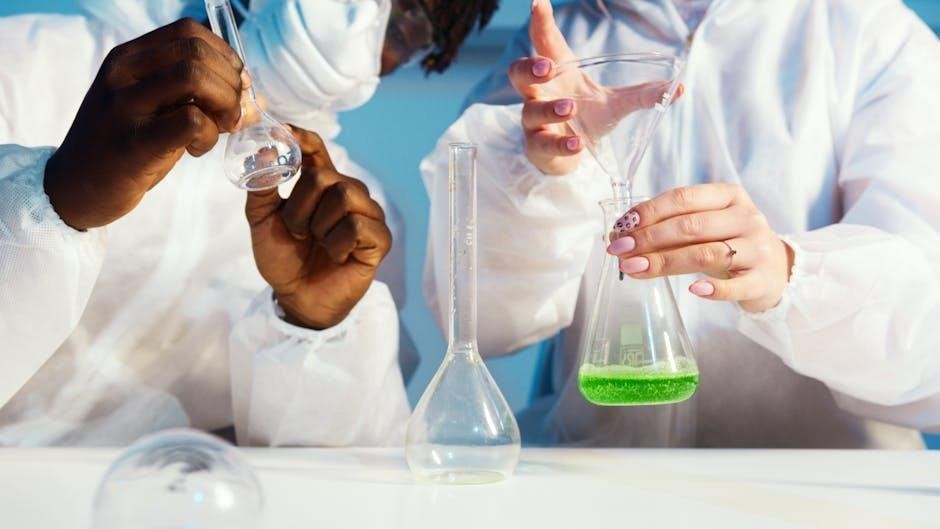
Common Mistakes to Avoid
Students often overlook reaction conditions‚ mislabel reactants/products‚ or miscalculate stoichiometric ratios. Ensure proper use of symbols and balanced equations to avoid errors in problem-solving.
10.1 Errors in Balancing Equations
One of the most common mistakes is forgetting to balance all elements‚ especially polyatomic ions. Students often miscount atoms or neglect to balance charges in redox reactions. Another error is rushing through the process‚ leading to carelessness. Always balance one element at a time and double-check each step. Using different colors to track elements can help. Remember‚ a balanced equation is fundamental for accurate stoichiometric calculations. Patience and attention to detail are key to avoiding these errors.
10.2 Misunderstanding Reaction Orders
A common mistake is confusing reaction order with stoichiometric coefficients. Reaction order refers to the sum of exponents in a rate law‚ not the balanced equation. Students often assume the order matches the coefficients‚ which is incorrect. Reaction orders are determined experimentally and can be fractional or zero. Misunderstanding this leads to errors in rate laws and calculations. Always verify reaction orders through experimental data rather than assuming them from the balanced equation. This ensures accurate predictions of reaction rates and mechanisms.
10.3 Incorrect Use of Stoichiometric Ratios
A common error is misapplying stoichiometric ratios in calculations. Students often confuse mole-to-mole ratios with mass-to-mass or volume-to-volume ratios. Always ensure the reaction is balanced first‚ as ratios depend on the balanced equation. Additionally‚ failing to convert units (e.g.‚ grams to moles) or misaligning reactants and products in ratios leads to incorrect results. Double-checking calculations and aligning ratios properly prevents such mistakes. This ensures accurate determination of limiting reactants and theoretical yields in chemical problems.
